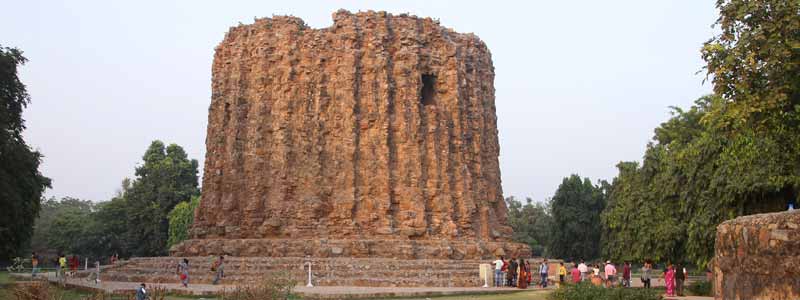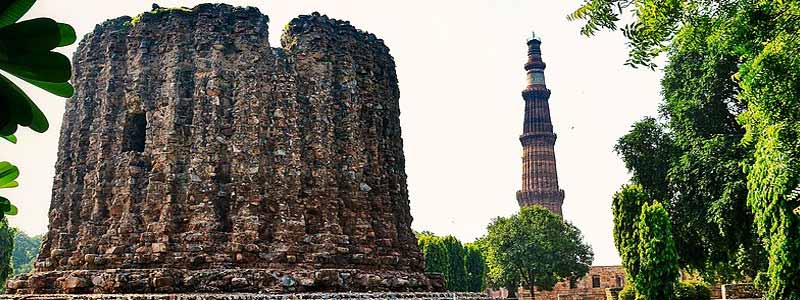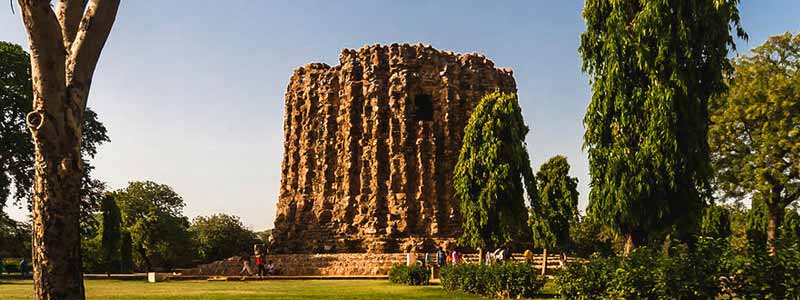Alai Minar in Delhi Among the many historical monuments present within the Qutub Minar complex, Alai Minar stands apart as it has been left incomplete. The construction was started by the Ilbari ruler Alauddin Khilji as a project to build a minar higher than the Qutub Minar. The ruler had high ambitions and wanted to be credited for many monuments of grandeur and splendour. After winning the Deccan war, he indulged in making modifications to the famous Quwwat-ul-Islam mosque within the same complex.
Once the mosque was doubled in size, Khilji proceeded to construct the highest tower as a mark of his prowess and victory. However, the minar was left incomplete as the king died in 1316 AD, very soon after the construction of the tower began. The complete description of the king’s intentions and the construction of the minar is mentioned in Amir Khusro’s book ‘Tarikh-e-Alai’ Delhi.
Alai Minar in Delhi was designed to be two times higher than the Qutub Minar and well proportioned with the Quwwat-ul-Islam mosque in the area. The idea was however abandoned and as of now, the building is an 80 feet high, mammoth rubble masonry, finished only up to one storey. The unhewn structure stands bare and suggests the creator’s intentions to be adorned with dressed stones and fancy architecture. The construction was not taken up by the descendants of the Khilji dynasty and eventually the minar was left unaddressed and neglected. But, even though in a derelict and a decrepit state, the monument resonates with the majesty and the magnificence of the bygone era.

History of Alai Minar
Sultan Ala-Ud-Din Khilji was an overly ambitious ruler. He was enraged to create this monument after winning a battle during his Deccan expeditions. He desired to erect this monument as a symbol of his victory Delhi Tour Packages.
The Sultan’s overly ambitious disposition drove him to construct a building that may be double the height of Qutub Minar. He desired that his structure be so tall that the entire world would be aware of the Sultan’s magnificence and bravery. He desired to produce a great masterpiece, and he desired that the world recognise this enormous masterpiece as the Sultan’s handiwork Alai Minar in Delhi.

Architecture of Alai Minar / Alai Minar was built by:
He began construction on the monument in accordance with the Sultan’s idea. The monarch desired that the enclosed Masjid Quwwat-Ul-Islam be expanded four times its original size. An entry gateway was built on both sides of the mosque to guarantee that the Sultan’s request was granted Alai Minar in Delhi.
He desired his monument to be taller than this mosque, and he also specified that it bear his name, therefore Alai Minar was born. Construction began in accordance with the Sultan’s plan.
The Alai Minar’s first level stood 24.5 metres tall. Unfortunately, Sultan died just after the first floor was completed, and the Minar’s development was put on hold. The Sultan’s ambitious spirit is reflected in the Alai Minar in Delhi. Despite the Sultan’s efforts, his monument could never be matched to Qutub Minar.

Historical Significance of Alai Minar
The Alai Minar is an incomplete monument within the Qutb complex in South Delhi. Sultan Ala-ud-Din Khalji was an over-ambitious Sultan of the Khilji dynasty and won many wars and battles. After a win in one of his Deccan campaigns, the Sultan dreamt of constructing a vast Tower or Minar to commemorate his victory. He wanted a structure double the height of Qutub Minar, to be remembered as the only Sultan who dared to create such a monumental masterpiece grander and more spectacular than the Qutub Minar of Qutb-ud-din Aibak of the Slave dynasty that ruled before him.
He wanted the Alai Minar to match up with the size of the increased height of the mosque and also enjoyed the second tower of victory under his name; hence the Alai Minar began to take its shape.
During the reign of the Khilji dynasty, a renowned Sufi poet named Amir Khusro mentions in one of his works called ‘Tareekh-i-Alai’ the Sultan’s intentions to increase the size of the mosque and the plan to construct the Alai Minar in Delhi. Amir Khusro was born in 1253 AD in Patiali in Northern India to Amir Sayf-ud-din Mahmud, a Turkic Officer.
Best Time To Visit Alai Minar
Winters, early Spring or Late Autumn, is the ideal time to visit this place due to the infamous Delhi heat. The summers can get scorching and sultry, and your visit can get unbearable and really uncomfortable.
How to reach Alai Minar
Alai Minar in Delhi is situated within the Qutub Minar complex. The nearest metro station to the Qutub Minar complex is Qutub Minar Metro station situated on the yellow line connecting Samaypur Badli and Huda City Centre. Delhi Transport Corporation (DTC) also runs state buses which are relatively more economical. The nearest bus stop to Qutub Minar complex is Mehrauli Bus Terminal. You can get down either at the bus stop or the metro station and can hire shared auto rickshaws or battery rickshaws to get to your destination.
Nearest Metro Stations : The Qutub Minar Metro Station on the Yellow line is the nearest metro station, located about 2 km away from the Qutub complex. E-Rickshaws, Autorickshaws, and Taxis are all available from the metro to take you to the monument.
From Delhi Railway Station : It is about 15 km from the New Delhi Railway station. You can easily get cabs, and autos or even take the metro from here to reach the Alia Darwaza. It will take about one hour to reach the location.
From Delhi Airport : Delhi Airport is 12 km from Darwaza.








